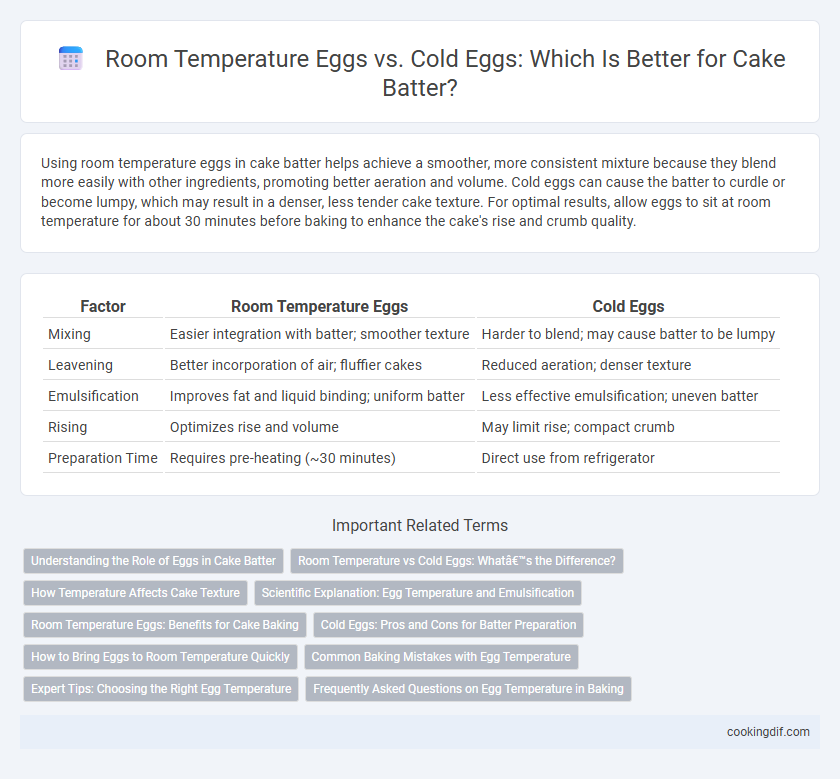Using room temperature eggs in cake batter helps achieve a smoother, more consistent mixture because they blend more easily with other ingredients, promoting better aeration and volume. Cold eggs can cause the batter to curdle or become lumpy, which may result in a denser, less tender cake texture. For optimal results, allow eggs to sit at room temperature for about 30 minutes before baking to enhance the cake's rise and crumb quality.
Table of Comparison
| Factor | Room Temperature Eggs | Cold Eggs |
|---|---|---|
| Mixing | Easier integration with batter; smoother texture | Harder to blend; may cause batter to be lumpy |
| Leavening | Better incorporation of air; fluffier cakes | Reduced aeration; denser texture |
| Emulsification | Improves fat and liquid binding; uniform batter | Less effective emulsification; uneven batter |
| Rising | Optimizes rise and volume | May limit rise; compact crumb |
| Preparation Time | Requires pre-heating (~30 minutes) | Direct use from refrigerator |
Understanding the Role of Eggs in Cake Batter
Eggs play a crucial role in cake batter by providing structure, moisture, and leavening through protein coagulation and air incorporation. Room temperature eggs blend more evenly with butter and sugar, promoting a stable emulsion that improves batter volume and texture. Cold eggs can cause the batter to curdle and result in uneven mixing, negatively affecting the cake's crumb and rise.
Room Temperature vs Cold Eggs: What’s the Difference?
Room temperature eggs blend more easily with other ingredients, resulting in a smoother, more consistent cake batter that rises better during baking. Cold eggs can cause butter to seize or batter to curdle, leading to uneven texture and denser cakes. For optimal cake structure and fluffiness, using room temperature eggs is essential in most baking recipes.
How Temperature Affects Cake Texture
Using room temperature eggs in cake batter promotes better emulsification, resulting in a smoother and lighter texture. Cold eggs can cause uneven mixing and denser crumb due to slower fat and liquid integration. Consistently, room temperature eggs help achieve a more tender and airy cake by improving batter consistency.
Scientific Explanation: Egg Temperature and Emulsification
Room temperature eggs blend more effectively into batter due to their lower viscosity, allowing fats and liquids to emulsify smoothly, which enhances texture and volume. Cold eggs can cause the fat to solidify temporarily, disrupting the emulsion and resulting in a denser, less airy cake structure. The scientific principle behind this is that warmer temperatures reduce the surface tension of proteins in eggs, facilitating better interaction with other ingredients.
Room Temperature Eggs: Benefits for Cake Baking
Room temperature eggs blend more easily into cake batter, creating a smoother and more uniform mixture that enhances cake texture. Using eggs at room temperature promotes better aeration, resulting in a lighter and fluffier cake crumb. Cakes made with room temperature eggs tend to rise more evenly due to improved emulsification of fats and liquids in the batter.
Cold Eggs: Pros and Cons for Batter Preparation
Cold eggs provide better structure and stability in batter due to their lower temperature, which helps maintain the integrity of air bubbles during mixing. However, they may slow down the emulsification process of fats and liquids, potentially resulting in a denser, less tender cake crumb. Bakers often balance the use of cold eggs with additional mixing techniques to optimize texture without compromising rise and softness.
How to Bring Eggs to Room Temperature Quickly
Cold eggs can slow down the mixing process and result in uneven batter texture, while room temperature eggs blend more smoothly for better cake rise. To quickly bring eggs to room temperature, place them in a bowl of warm water (around 100degF or 38degC) for 5 to 10 minutes. This method gently warms the eggs without cooking them, ensuring optimal consistency for cake batter.
Common Baking Mistakes with Egg Temperature
Using cold eggs directly from the refrigerator in cake batter often leads to uneven mixing and a dense texture because cold eggs don't incorporate air as effectively. Room temperature eggs blend more smoothly with other ingredients, enhancing the batter's consistency and promoting better rise during baking. One common baking mistake is neglecting to bring eggs to room temperature, which can sabotage the final cake's tenderness and volume.
Expert Tips: Choosing the Right Egg Temperature
Room temperature eggs blend more easily into cake batter, creating a smoother, more consistent texture by helping fats emulsify properly. Cold eggs can cause the batter to curdle or become lumpy, affecting the rise and crumb of the finished cake. Expert bakers recommend warming eggs to around 70degF (21degC) before mixing to ensure optimal aeration and tender crumb development.
Frequently Asked Questions on Egg Temperature in Baking
Using room temperature eggs in cake batter allows for better emulsification and a smoother, more consistent texture during mixing. Cold eggs can cause the batter to curdle or mix unevenly, affecting the rise and crumb of the cake. Bakers often ask whether warming eggs to room temperature enhances the overall cake quality, and sources confirm that this practice improves volume and helps ingredients blend more effectively.
Room Temperature Eggs vs Cold Eggs for batter Infographic

 cookingdif.com
cookingdif.com